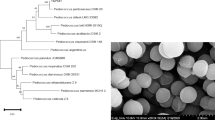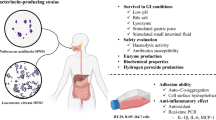Abstract
This study aimed to investigate the probiotic potential of Pediococcus pentosaceus L1 isolated from paocai, a Chinese fermented vegetable. In vitro analysis revealed that P. pentosaceus L1 had the capability to tolerate simulated gastrointestinal juices. Adhesion of P. pentosaceus L1 to HT-29 intestinal epithelial cells (IEC) was also observed. L1 was sensitive to ampicillin, gentamycin, kanamycin, strepomycin, clindamycin, tetracycline and chloramphenicol. L1 showed effective inhibition against Escherichia coli, Salmonella typhimurium, and Shigella flexneri. P. pentosaceus L1 also exhibited the abilities of auto-aggregation and co-aggregation with Shigella flexneri. Pre-treatment of HT-29 IEC with P. pentosaceus L1 prior to tumor necrosis factor-alpha (TNFα) challenge down-regulated the expression of pro-inflammatory genes, such as IL8, CCL20, CXCL10, and CXCL1. The level of IL-8 released in culture supernatant of TNFα-challenged HT-29 IEC was reduced by strain L1, confirming the observed decrease in TNFα-induced IL-8 mRNA expression. These results indicate the probiotic potential of P. pentosaceus L1, and that this strain could be used to produce functional foods.




Similar content being viewed by others
References
Abrams D, Barbosa J, Albano H, Silva J, Gibbs PA, Teixeira P (2011) Characterization of bacPPK34 a bacteriocin produced by Pediococcus pentosaceus strain K34 isolated from “Alheira”. Food Control 22:940–946
Ammor MS, Flórez AB, Mayo B (2007) Antibiotic resistance in non-enterococcal lactic acid bacteria and bifidobacteria. Food Microbiol 24:559–570
Aslim B, Onal D, Beyatli Y (2007) Factors influencing autoaggregation and aggregation of Lactobacillus delbrueckii subsp. bulgaricus isolated from handmade yogurt. J Food Prot 70:223–227
Begley M, Gahan CGM, Hill C (2005) The interaction between bacteria and bile. FEMS Microbiol Rev 29:625–651
Billot-Klein D, Gutmann L, Sable S, Guittet E, van Heijenoort J (1994) Modification of peptidoglycan precursors is a common feature of the low-level vancomycin-resistant VANB-type Enterococcus D366 and of the naturally glycopeptide-resistant species Lactobacillus casei, Pediococcus pentosaceus, Leuconostoc mesenteroides, and Enterococcus gallinarum. J Bacteriol 176:2398–2405
Carafa I, Nardin T, Larcher R, Viola R, Tuohy K, Franciosi E (2015) Identification and characterization of wild lactobacilli and pediococci from spontaneously fermented Mountain Cheese. Food Microbiol 48:123–132
Chiu HH, Tsai CC, Hsih HY, Tsen HY (2008) Screening from pickled vegetables the potential probiotic strains of lactic acid bacteria able to inhibit the Salmonella invasion in mice. J Appl Microbiol 104:605e612
Cocolin L, Dolci P, Rantsiou K (2011) Biodiversity and dynamics of meat fermentations: the contribution of molecular methods for a better comprehension of a complex ecosystem. Meat Sci 89:296–302
Collado MC, Meriluoto J, Salminen S (2007) Role of commercial probiotic strains against human pathogen adhesion to intestinal mucus. Lett Appl Microbiol 45:454–460
EFSA (2012) Guidance on the assessment of bacterial susceptibility to antimicrobials of human and veterinary importance. EFSA J 10:2740–2749
Food and AgricultureOrganization/World Health Organization (2006) Probiotics in food: health and nutritional properties and guidelines for evaluation. FAO Food and Nutrition Paper 85. FAO, Rome
Feng M, Chen X, Li C, Nurgul R, Dong M (2012) Isolation and identification of an exopolysaccharide-producing lactic acid bacterium strain from Chinese Paocai and biosorption of Pb(II) by its exopolysaccharide. J Food Sci 77:T111–T117
Fernandez MF, Boris S, Barbes C (2003) Probiotic properties of human lactobacilli strains to be used in the gastrointestinal tract. J Appl Microbiol 94:449–455
García-Ruiz A, de Llano DG, Esteban-Fernández A, Requena T, Bartolomé B, Moreno-Arribas MV (2014) Assessment of probiotic properties in lactic acid bacteria isolated from wine. Food Microbiol 44:220–225
Garsa AK, Kumariya R, Kumar A, Lather P, Kapila S, Sood SK, Kapasiva M (2014) In vitro evaluation of the probiotic attributes of two pediococci strains producing pediocin PA-1 with selective potency as compared to nisin. Eur Food Res Technol 239:491–499
Gong C, Yu W, Zhang Q, Song P, Zhang B, Zhu L, You J, Li F (2014) Research of sichuan paocai and lactic acid bacteria. Adv J Food Sci Technol 6:1–5
Halami PM, Ramesh A, Chandrashekar A (2005) Fermenting cucumber, a potential source for the isolation of pediocin-like bacteriocin producers. World J Microbiol Biotechnol 21:1351–1358
Huang Y, Luo Y, Zhai Z, Zhang H, Yang C, Tian H, Li Z, Feng J, Liu H, Hao Y (2009) Characterization and application of an anti-Listeria bacteriocin produced by Pediococcus pentosaceus 05-10 isolated from Sichuan Pickle, a traditionally fermented vegetable product from China. Food Control 20:1030–1035
Huang J, Wu Y, Chi S (2014) Dietary supplementation of Pediococcus pentosaceus enhaces innate immunity, physiological health and resistance to Vibrio anguillarum in orange-spotted grouper (Epinephelus coioides). Fish Shellfish Immunol 39:196–205
Hwanhlem N, Watthanasakphuban N, Riebroy S, Benjakul S, H-Kittikun A, Maneerat S (2010) Probiotic lactic acid bacteria from Kung-Son: isolation, screening, inhibition of pathogenic bactria. Int J Food Sci Technol 45:594–601
Ilavenil S, Vijayakumar M, Kim DH, Valan Arasu M, Park HS, Ravikumar S, Choi KC (2015) Assessment of probiotic, antifungal and cholesterol lowering properties of Pediococcus pentosaceus KCC-23 isolated from Italian ryegrass. J Sci Food Agric. doi:10.1002/jsfa.7128
Jonganurakkun B, Wang Q, Xu SH, Tada Y, Minamida K, Yasokawa D, Sugi M, Hara H, Asano K (2008) Pediococcus pentosaceus NB-17 for probiotic use. J Biosci Bioeng 106:69–73
Kos B, Susković J, Vuković S, Simpraga M, Frece J, Matosić S (2003) Adhesion and aggregation ability of probiotic strain Lactobacillus acidophilus M92. J Appl Microbiol 94:981–987
Lebeer S, Vanderleyden J, De Keersmaecker SC (2008) Genes and molecules of lactobacilli supporting probiotic action. Microbiol Mol Biol Rev 72:728–764
Leroy F, Falony G, De Vuyst L (2008) Latest developments in probiotics. In: Toldrà F (ed) Meat biotechnology. Springer New York, pp 217–229
Lv LX, Li YD, Hu XJ, Shi HY, Li LJ (2014) Whole-genome sequence assembly of Pediococcus pentosaceus LI05 (CGMCC 7049) from the human gastrointestinal tract and comparative analysis with representative sequences from three food-borne strains. Gut Pathog 6:36
Maragkoudakis PA, Zoumpopoulou G, Miaris C, Kalantzopoulos G, Pot B, Tsakalidou E (2006) Probiotic potential of Lactobacillus strains isolated from dairy products. Int Dairy J 16:189–199
Masuda T, Kimura M, Okada S, Yasui H (2010) Pediococcus pentosaceus Sn26 inhibits IgE production and the occurrence of ovalbumin-induced allergic diarrhea in mice. Biosci Biotechnol Biochem 74:329–335
McDonald LC, Fleming HP, Hassan HM (1990) Acid tolerance of Leuconostoc mesenteroides and Lactobacillus plantarum. Appl Environ Microbiol 56:2120–2124
Monteagudo-Mera A, Rodriguez-Aparicio L, Rua J, Martinez-Blanco H, Navasa N, Garcia-Armesto MR, Ferrero MA (2012) In vitro evaluation of physiological probiotic properties of different lactic acid bacteria strains of dairy and human origin. J Funct Foods 4:531–541
Osmanagaoglu O, Kiran F, Ataoglu H (2010) Evaluation of in vitro probiotic potential of Pediococcus pentosaceus OZF isolated from human breast milk. Probiotics Antimicrob Proteins 2:162–174
Osmanagaoglu O, Kiran F, Yagci FC, Gursel I (2013) Immunomodulatory function and in vivo properties of Pediococcus pentosaceus OZF, a promising probiotic strain. Ann Microbiol 63:1311
Peres CM, Peres C, Hernández-Mendoza A, Malcata FX (2012) Review on fermented plant materials as carriers and sources of potentially probiotic lactic acid bacteria—with an emphasis on table olives. Trends Food Sci Technol 26:31–42
Pfaffl MW, Horgan GW, Dempfle L (2002) Relative expression software tool (REST) for group-wise comparison and statistical analysis of relative expression results in real-time PCR. Nucleic Acids Res 30:e36
Pfaffl MW, Tichopad A, Prgomet C, Neuvians TP (2004) Determination of stable housekeeping genes, differentially regulated target genes and sample integrity: BestKeeper—Excel-based tool using pair-wise correlations. Biotechnol Lett 26:509–515
Ramakers C, Ruijte JM, Deprez RH, Moorman AF (2003) Assumption-free analysis of quantitative real-time polymerase chain reaction (PCR) data. Neurosci Lett 339:62–66
Ruas-Madiedo P, de los Reyes-Gavilan CG (2005) Invited review: methods for the screening, isolation, and characterization of exo-polysaccharides produced by lactic acid bacteria. J Dairy Sci 88:843–856
Ryu EH, Chang HC (2013) In vitro study of potentially probiotic lactic acid bacteria strains isolated from kimchi. Ann Microbiol 63:1387–1395
Saxelin M, Tynkkynen S, Mattila-Sandholm T, de Vos WM (2005) Probiotic and other functional microbes: from markets to mechanisms. Curr Opin Biotechnol 16:204–211
Shukla R, Goyal A (2014) Probiotic potential of Pediococcus pentosaceus CRAG3: a new isolate from fermented cucumber. Probiotics Antimicrob Protein 6:11–21
Tamura K, Dudley J, Nei M, Kumar S (2007) MEGA4: molecular evolutionary genetics analysis (MEGA) software version 4.0. Mol Biol Evol 24:1596–1599
Tejero-Sariñena S, Barlow J, Costabile A, Gibson GR, Rowland I (2012) In vitro evaluation of the antimicrobial activity of a range of probiotics against pathogens: evidence for the effects of organic acids. Anaerobe 18:530–538
Thomas CM, Versalovic J (2010) Probiotics-host communication: modulation of signaling pathway in the intestine. Gut Microbes 1:1–16
Thompson JD, Gibson TJ, Plewniak F, Jeanmougin F, Higgins DG (1997) The ClustalX windows interface: flexible strategies for multiple sequence alignment aided by quality analysis tools. Nucleic Acids Res 25:4876–4882
Uymaz B, Şimşek Ö, Akkoç N, Ataoğlu H, Akçelik M (2009) In vitro characterization of probiotic properties of Pediococcus pentosaceus BH105 isolated from human faeces. Ann Microbiol 59:485–491
Varsha KK, Priya S, Devendra L, Nampoothiri KM (2014) Control of spoilage fungi by protective lactic acid bacteria displaying probiotic properties. Appl Biochem Biotechnol 172:3402–3413
Vidhyasagar V, Jeevaratnam K (2013) Evaluation of Pediococcus pentosaceus strains isolated from Idly batter for probiotic properties in vitro. J Funct Foods 5:235–243
Zhang Y, Zhang L, Du M, Yi H, Guo C, Tuo Y, Han X, Li J, Zhang L, Yang L (2011) Antimicrobial activity against Shigella sonnei and probiotic properties of wild lactobacilli from fermented food. Microbiol Res 167:27–31
Zhao X, Higashikawa F, Noda M, Kawamura Y, Matoba Y, Kumagai T, Sugiyama M (2012) The obesity and fatty liver are reduced by plant-derived Pediococcus pentosaceus LP28 in high fat diet-induced obese mice. PLoS One 7:e30696
Acknowledgments
This study was supported by the National Natural Science Foundation of China (Grant No. 31501496), the Project Sponsored by Scientific Research Foundation for the Returned Overseas Chinese Scholars, State Education Ministry (Grant No. (2013)1792), the Key Program of Scientific Research Foundation of Yunnan Provincial Department of Education (Grant No. 2013Z024), the Program supported by Yunnan Provincial Key Laboratory of Animal Nutrition and Feed Science (Grant No. DYKF2015006) and the Post-doctoral program from Dalian SEM Bio-Engineering Technology Co. Ltd..
Author information
Authors and Affiliations
Corresponding author
Ethics declarations
Conflict of interest
The authors declare that they have no conflict of interests.
Additional information
Zhenhui Cao and Hongbin Pan contributed equally to this work.
Electronic supplementary material
Below is the link to the electronic supplementary material.
ESM 1
(PDF 122 kb)
Rights and permissions
About this article
Cite this article
Cao, Z., Pan, H., Tong, H. et al. In vitro evaluation of probiotic potential of Pediococcus pentosaceus L1 isolated from paocai—a Chinese fermented vegetable. Ann Microbiol 66, 963–971 (2016). https://doi.org/10.1007/s13213-015-1182-2
Received:
Accepted:
Published:
Issue Date:
DOI: https://doi.org/10.1007/s13213-015-1182-2




